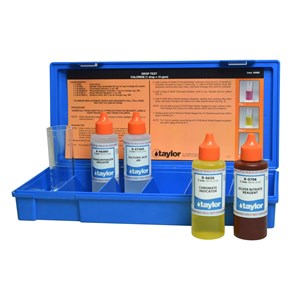K-1549S
Drop Test, Chloride, Argentometric (for hi pH waters), 1 drop = 10 ppm
- UPC Barcode:
- 840036011096
$87.31
Description of Tests
| Analyte | System | Method/Chemistry | Standard/Equivalance or Description | Comparator | Cell |
|---|---|---|---|---|---|
| Chloride | Drop test | Argentometric (high pH waters) | 1 drop = 10 ppm Clˉ | NA | 9198O |
Potential Interferences
| Test Parameter | Description |
|---|---|
| Orthophosphate at concentrations greater than 25 ppm will precipitate as silver phosphate to cause positive interference. This can be prevented by diluting orthophosphate concentrations below 25 ppm with DI water. Bromide, iodide, and cyanide at all levels titrate as equivalent chloride concentrations. Sulfide, thiosulfate, and sulfite interfere but can be removed by treatment with hydrogen peroxide. Quats may interfere; to prevent add 10 drops of R-0884. | Chloride |
Shelf Life Concerns
REAGENT SHELF LIFE
All reagents have a shelf life, whether they are liquids, powders, crystals, tablets, or test-strip pads. If kept dry, powders and crystals are very stable; acids are also long lived. Date of manufacture is not the controlling factor when it comes to shelf life—storage conditions are more important. As with all perishables, reagents are sensitive to environmental influences and will last longer under controlled conditions.
To this end, we recommend:
- Storing reagents at a consistent temperature in the range if 36°–85°F (2°–29°C); extreme temperature fluctuation, say from a refrigerator to a hot car trunk, causes reagents to deteriorate.
- Keeping them out of prolonged direct sunlight. (Note: their brown plastic bottles help protect very light-sensitive reagents.)
- Segregating reagents from containers of treatment chemicals.
- Replacing caps immediately and tightening them carefully so that exposure to air and humidity is limited.
- Avoiding switching bottle caps, placing bottle caps on soiled surfaces, repouring reagents into contaminated containers, or touching test strip pads.
Taylor formulates its reagents to remain effective for at least one year, with only very few exceptions (molybdenum indicator in liquid form is one; after four months old it should be tested against a standard periodically). As a general precaution, replace all reagents more than one year old, or at the beginning of a new testing season.
Suggested Items
Accessories
Kit Video K-2005
Warnings




 0630
0630
